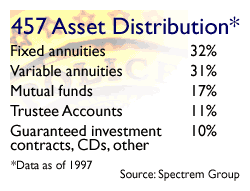|
Pros and cons of 457 plan
|
 |
March 23, 2000: 9:52 a.m. ET
It pays to supplement your pension if you work for a state or local agency
By Staff Writer Jeanne Sahadi
|
NEW YORK (CNNfn) - While public-service employees enjoy the security of solid pension plans, there's no guarantee that those plans alone will make retirement comfortable -- which is why many government workers might want to consider contributing to 457 retirement savings plans if offered by their employer.
The 457 plan is similar to the 401(k) that is common in the private sector and offers similar advantages. The biggest boon is tax deferral. Contributions to a 457 are taken from your gross income, reducing your taxable wages. Your money then grows tax-deferred until you withdraw it, at which point it will be taxed as income.
And because, like a 401(k), the deductions are automatic, a 457 offers one of the more painless ways to save for retirement.
After that, however, the 457 distinguishes itself -- for better and worse.
Contributions, rollovers limited
Take contribution levels. A participant in a 457 plan is allowed to contribute up to 25 percent of annual gross income but not more than $8,000 per year, said Marty Walton, manager of the 457 plan for California Public Employees' Retirement System (CalPERS).
 Unless federal regulations change, the 457 contribution level may not catch up to that of the 401(k), which currently stands at $10,500. Both are tied to cost of living increases, and the 457 cap will only rise if the cost of living goes up enough to justify a $500 jump, Walton said. Unless federal regulations change, the 457 contribution level may not catch up to that of the 401(k), which currently stands at $10,500. Both are tied to cost of living increases, and the 457 cap will only rise if the cost of living goes up enough to justify a $500 jump, Walton said.
When it comes to matching contributions, some plans may offer them but, generally speaking, he said, "With 457s, matches are pretty rare."
Your rollover options are also limited. You may only roll over 457 money into another 457, not into an IRA, a 401(k) or a 403(b), the retirement plan offered at many nonprofits.
And if your 457 investments are in annuities -- the traditional investment vehicle for such plans -- you may have to pay an early withdrawal fee or surrender charge to the insurance company to rollover. That fee may be as high as 5 percent if you held your account for five years or less, Walton said.
Catch-up provision a plus
 One of the advantages a 457 has over a 401(k) plan, however, is its catch-up provision. If you failed to maximize your contributions or did not contribute at all during some years, you may increase your annual contribution to a maximum of $15,000 in the three calendar years before you hit "normal" retirement age, Walton said. One of the advantages a 457 has over a 401(k) plan, however, is its catch-up provision. If you failed to maximize your contributions or did not contribute at all during some years, you may increase your annual contribution to a maximum of $15,000 in the three calendar years before you hit "normal" retirement age, Walton said.
"Normal" varies state by state and will be defined by your plan. In the case of CalPERS, it is the earliest age at which you may collect your pension so long as you have put in five years of service.
Keep in mind that not everyone can put in $15,000 automatically. Your catch-up amount is determined by a formula based on how much you contributed in previous years.
Distributions when you want them
Another distinguishing factor is the distribution policy. You must start taking distributions in the year after you turn 70-1/2 if you haven't already done so, Walton said, but you may do so well before that if you wish.
Unlike with a 401(k), you will not pay a penalty to withdraw 457 money when you leave a job, even if you're 25.
"Qualifying for distribution is not tied to your age," Walton said. "It's tied to when you separate from your employer."
This feature is intended to provide for public servants like policemen and firemen who work in hazardous occupations from which they often retire well before 62.
"You don't want a 70-year-old fireman climbing a ladder. You don't want to penalize those people," Walton said.
Stay the course
Most financial advisers recommend that investors not withdraw their retirement funds when they're young or middle-aged, so as not to lose out on tax-deferred compounding. But there may be times when it makes sense for a 457 participant to use the money before their later years, said certified financial planner Marysue Wechsler.
Say, for example, that a policeman retires at 40 and takes a job as a detective in the private sector. "He still has another 25 years to contribute to a 401(k)," Wechsler said. And he may need the money to help put his kids through college.
But, she added, "Whenever you can leave it, then leave it."
If you want to keep your investments where they are when you quit, you must notify your employer when you would like to start taking distributions from the plan.
Choosing between a 457 and 401(k)
You should be aware of the pros and cons of a 457, especially if you have the option to invest in a 401(k). The 1986 Tax Reform Act prohibits public-service employers from providing 401(k)s, but allowed those agencies with plans in place by 1988 to keep them.
Some things to compare are investment choice and cost. Investment choice is typically broader in 401(k)s, but not always. CalPERS' 457, for instance, offers eight core mutual funds that include large-cap, small-cap, bond and international funds.
When it comes to cost, if your 457 is heavily weighted in annuities, your upfront charges may be higher than some mutual fund loads, said Ron Snyder, an attorney and enrolled actuary with the Benefit Strategies Group.
Given those factors, plus the better contribution level and rollover options, it may make sense to opt for the 401(k). "That's a no-brainer," Snyder said.
Maximize your money
But even if a 457 is your only option at work, it's a benefit you shouldn't pass up. No other investment will give you the same tax-advantaged opportunity, which is why investment management consultant Lance Wallach and others advise that you max out your contributions.
That may seem burdensome, but there could be hidden money you're not tapping. If you have children and qualify for the $500-per-child tax credit, for instance, Wechsler said you can adjust your withholdings to reflect the credit ordinarily used to reduce your tax bite and channel the extra gross income toward your 457.
If you can afford it, she said, contribute to a Roth IRA as well to expand your investment horizon.
Educate yourself
If you have questions about your 457, you need to be pro-active about asking your employer for more information.
"There is no comprehensive source on everything you ever wanted to know about a 457," said Walton, whose plan details are available to CalPERS members on the Web.
And, experts suggest, if you and other employees are dissatisfied with a plan, you may consider lobbying your agency for change. 
|
|
|
|
|
 |

|

